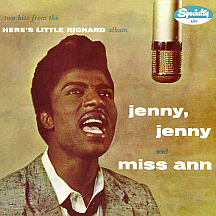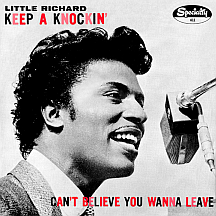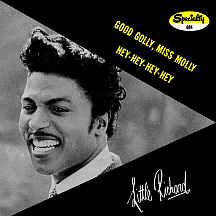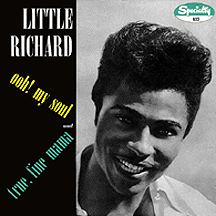LITTLE RICHARD
If any artist on the '50s music scene was more flamboyant, more capable of working a crowd into a state of hysteria, more shockingly sexual and controversial than Little Richard, I don't know who it is. The one person who could answer that question with reasonable accuracy would be Richard himself; one possible suspect might be Esquerita, on whom he patterned his original style, while there were certainly others of limited fame who performed on the backroad, southern sideshow circuit, many of whom crossed paths with the Macon, Georgia-born artist during his youth. But the singer-pianist born Richard Penniman in December 1932 is the one who achieved worldwide fame and thus took an enormous amount of criticism from the many who felt his type of music (and Elvis's and Chuck's and Jerry Lee's, et al) marked the beginning of the end of civilization!
Growing up with a strict father, Charles "Bud" Penniman, and loving mother, Leva Mae, having seven brothers and four sisters didn't stop Richard from often pulling pranks on his siblings with little concern about being beaten for it...which he was, often. He daydreamed about being born a girl, a secret wish he didn't reveal for many years. A natural singer, he performed in church and around town with a group of youngsters that called themselves "The Tiny Tots." Around the age of 14, while working at the Macon City Auditorium selling soft drinks, he boldly approached Sister Rosetta Tharpe, who was performing that night; she had him come onstage during the show to sing a duet, which was a great thrill for the young boy and made him start thinking seriously about a show business career. He began practicing saxophone as a freshman at Hudson High School, making his mom crazy as he constantly played it around the house.
Motivated to run away due to his father's abusive nature, singer-saxophonist Richard left home shortly thereafter and joined an outfit called Dr. Hudson's Medicine Show. He sang with a number of bands over the next few years, though some were hesitant to hire an effiminate, underage kid. He began using the name Little Richard and traveled with bands like Sugarfoot Sam from Alabam and The Tidy Jolly Steppers, often coming into contact with homosexual adults, an exciting thing to young Richard, who hadn't quite decided whether he was straight, gay or bi. He performed with the King Bros. Circus for a short time...and every so often he would show up in Macon to resume life with the family, until the next entertainment opportunity arose.
A bigger break came when Richard joined a traveling show called the Broadway Follies, which played regularly in Atlanta, the big time as far as he was concerned. He met Billy Wright (who had a few R&B hits between 1949 and '51 including "Blues For My Baby"); Wright was a regular at the Royal Peacock Club in Atlanta and had considerable influence over Richard, who imitated Billy's vocal sound and began styling his hair in a similar pompadour. South Carolinian Esquerita was another, even larger, influence; Richard met him around 1951 and patterned his look more closely after this singer than anyone else (in the later '50s and '60s, Esquerita made records for Capitol, Minit, Okeh and other labels using variations on the name including Eskew Reeder and S.Q. Reeder).
Wright called on Zenas Sears, who hosted The Blues Caravan on WGST radio, to help get Little Richard a contract with RCA Victor Records. His early recordings were made at the station's studio on the campus of the Georgia Institute of Technology. Songs like "Taxi Blues" and "Why Did You Leave Me?," while expertly produced with Richard in fine vocal form, came off as little more than standard blues and rhythm tunes popular at the time; "Get Rich Quick," his second single, was probably the closest to rock and roll of the bunch. Still, none of the eight sides issued by RCA in 1951 and '52 were particularly unique and they weren't strong sellers.
When his contract with RCA ended, Richard returned to Macon and took a job as a dishwasher at the city's Greyhound bus station. His father, who'd been selling bootleg liquor for years, was shot to death in 1952. Richard believed someone had ordered the killing, a theory that was never proven, though it was revealed a man named Frank Tanner committed the crime and amazingly was not prosecuted for it. Richard remained for a time to earn much-needed money to help support the family. Later a local promoter, Clint Brantley, took the singer-dishwasher under his wing, urging him to put a band together. The Tempo Toppers played clubs throughout the southern U.S., enjoying long engagements in New Orleans and Houston. As Richard became more comfortable performing onstage, he let his true colors fly, wearing bright, frilly, lacy outfits, sometimes appearing androgynous while at other times overtly feminine, and the primarily black patrons loved it. During his show, he took to calling himself "The King of the Blues...and the Queen, too!"
Don Robey of Peacock Records in Houston witnessed this bold behavior and signed the singer-crossdresser to a contract in early 1953. An arrogant, controlling type with a mean-spirited temper and bodyguards to cover his back, Robey maintained heavy-handed control over the artists on his label and Little Richard didn't like it one bit. He recorded several songs for Peacock, some with Johnny Otis and his orchestra, but nothing was released until after he'd hit the big time. Robey dropped him, the Tempo Toppers sort of imploded at that point, and Little Richard formed The Upsetters; his main men in the band were saxophonist Wilbert "Lee Diamond" Smith and drummer Charles "Chuck" Connors. One of their most popular numbers was "Tutti-Frutti," a "vulgar" song as Richard called it ('Tutti-Frutti, good booty...if it don't fit, don't force it...'); he certainly knew what worked on the circuit, because the nightclub crowds went berserk over uptempo, off-color songs of this type.
In 1954, Richard met Lloyd Price, who'd been a headliner since breaking through with a number one R&B hit, "Lawdy Miss Clawdy," a couple of years earlier. Lloyd suggested he contact Art Rupe at Specialty Records in Los Angeles. An audition tape was thrown together in early '55 at a small local radio station; Richard and the band were on the road when Specialty finally got back to him several months later. Robert "Bumps" Blackwell was doing A&R at Specialty (over the course of a few years he played a major role in the development of Price, Sam Cooke and Larry Williams) and convinced Rupe to sign Richard, sight-unseen, based on his tape. Arrangements were made to record a few songs at Cosimo Matassa's studio in New Orleans, the tiny back-room-with-a-tape-deck that already had a reputation as the birthplace of many great records (Fats Domino's hits and Price's "Lawdy," to give just two examples). Diamond, Connors and Penniman drove to the Crescent City, getting there just in time for the scheduled session that was to change Richard's life.
Blackwell was impressed by Richard's flashy clothes and pompdour and especially his wildly energetic personality. The first songs recorded for Specialty were blues-type tracks backed by the best musicians around, the guys that had played on Domino's big hits: sax madmen Alvin "Red" Tyler and Lee Allen, pianists Huey Smith and James Booker, bassist Frank Fields and drummer Earl Palmer. Bumps was confident about the hit potential of "Tutti-Frutti," but Richard's words had to be cleaned up. Dorothy LaBostrie, a young songwriter who'd been pestering him to record her songs, got her big break; she changed 'Tutti-frutti, good booty' to 'Tutti-frutti, aw-rootie...' and so on, while Richard's tongue-twisting first line, 'Wop-bop-a-loo-mop-a-lop-bop-bom,' remained intact. Blackwell was right about its chances of making it; the disc landed on the R&B charts in November '55 and hit number two in January '56 ("The Great Pretender" by The Platters proving 'Too real,' er, too hot to topple). The record reached the pop top 20...and an anemic cover by Pat Boone fared even better.
The next single, "Long Tall Sally," credited Enotris Johnson as its composer, though his wife, Ann Johnson, may have actually packed the lyrical punch. The line 'Have some fun tonight!' drives the oddly pieced-together narrative of Aunt Mary, Uncle John and ('bald headed') Sally. This second effort spent most of April and May at number one R&B and became his first pop top ten, this time outselling (yet another!) hit cover by Pat, who clearly found lines like 'Duck back in the alley!' challenging. End result: a garbled mess from squeaky-clean idol Boone, who henceforth sidestepped opportunities to do any more Little Richard material. The B side, "Slippin' and Slidin'" (...peepin' and a-hidin'...'), was also a hit for Richard. With the cut-rate (thanks to Rupe) royalty payments he received for his two singles he was able to buy his mother a home in West Los Angeles, moving her up from Georgia and out of that shack.
Rocking party song "Rip It Up" jumped to number one R&B in August; it and flip "Ready Teddy," both penned by Blackwell and John Marascalco, were pop hits as well. The flamboyant image of "The Architect of Rock and Roll" (as he later referred to himself) was on full display with all the wild outfits, a spectacle quite unlike anyone else (at his level of popularity, at least). His onstage energy incited audiences to dance, scream and sometimes jump from the balcony with reckless abandon. Singer-hitmaker Richard, more than perhaps any other early rock artist, caused a great deal of concern; many older folks were traumatized by the mere suggestion of such behavior. If only they'd known what went on behind the scenes, decadence like many people couldn't imagine: kinky sex, straight or gay in groups of two, three or five, it didn't matter, drinking, drugs, you name it. Richard has commented on being surprised he survived it all.
"She's Got It" retained the frantic tone of its predecessors. Most of Richard's material contained nonsensical lyrics and phrases (such as the flip, "Heeby-Jeebies"); nothing else on the charts had such an urgent pace as his records, arranged as if they absolutely had to reach a climax at the two-minute mark. In December '56, The Girl Can't Help it hit theaters starring Tom Ewell and title hottie Jayne Mansfield; Little Richard and the Upsetters performed the title theme (penned by Bobby Troup), "She's Got It" and "Ready Teddy" in the color funfest that also showcased rock and rollers Fats Domino, the Platters, Gene Vincent, The Treniers, Eddie Cochran and Eddie Fontaine in addition to Troup's future wife, "Cry Me a River" girl Julie London. Don't Knock the Rock, starring Alan Freed and Bill Haley and his Comets, came on its heels a couple of weeks later; in this one, Richard rocked with his two biggies, "Tutti-Frutti" and "Long Tall Sally," while Haley did his cover of "Rip It Up," which had shared space on the charts that summer with the original.
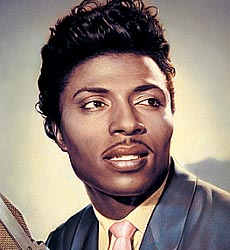
Art Rupe had such a good thing going with Little Richard that he kept an eye peeled for talented artists capable of delivering something similar. He signed New Orleans' Larry Williams, who had the chops to do a decent L.R. soundalike on songs arranged like those of "The Originator" (another of Richard's nicknames), and crazy hit songs like "Short Fat Fannie" and "Bony Moronie" resulted. Meanwhile, Richard hit big with "Lucille" and its strong ballad B side "Send Me Some Lovin'," followed by a two-sided girl-title smash, "Jenny, Jenny" and its hit flip, "Miss Ann." Another Freed flick was filmed with Richard doing "Lucille," but by the time the movie had its fall '57 theatrical run, Little Richard's entire attitude had changed.
The self-indulgent life of a rocker had created a conflict with Little Richard's faith. He no longer allowed the anything-goes party-orgies, instead quoting from the good book in bible-study-type get-togethers in his room. The little devil on one shoulder had been duking it out with the little angel on the other shoulder. He was torn...between the rock and roll lifestyle that he lived to the limit...and the religious beliefs he was raised with. The angel won this particular round; during the fall of 1957, right in the middle of a tour of Australia, he decided to abandon his R&R career and return to God full time. The tour was abruptly canceled, a costly move for everyone involved.
Some great recordings that had already been completed were released in late '57 and '58, like "Keep a Knockin'," a shoutin', sax-screamin' rock classic, and the equally unbridled "Good Golly, Miss Molly," both top ten hits on the pop and R&B charts. During this time, he was off the radar of the general public, unwilling and unable to give fans the kind of live-show stimulation they craved. Richard had taken to preaching the gospel as he felt one of the Lord's chosen Apostles would have done...traveling from meeting to meeting in the yellow Cadillac bought with his ill-gotten rock and roll money. He wore nice suits and made a strong, respectable impression; in July 1959, singer-minister Richard Penniman married Ernestine Campbell, an office secretary he had met shortly after beginning his new life of religious servitude.
After "Ooh! My Soul" and "Baby Face" in the summer and fall of 1958, Rupe ran out of hit-worthy material, though he released several more Little Richard singles through decade's end. Some of Richard's earliest spiritual records came out in 1959 on the End label. He toured with gospel great Mahalia Jackson, who was delighted by his clean-cut appearance and demeanor after the unsettling things she'd heard. The title of his 1961 gospel album on Mercury, The King of the Gospel Singers, suggested he still possessed some of that worldly pride; the work itself, recorded in a purely religious manner with the Quincy Jones orchestra, went a long way towards convincing many that he had permanently found salvation. A single, "He's Not Just a Soldier," was a gospel hit.
The return to his self-admitted sinful ways came gradually and when Ernestine realized what was going on, she divorced him. On a tour of England in 1962, Richard 's intention was to do gospel material, but the promoters there had other ideas. Going along with the plan, he made the crowds crazy with his hits, from "Tutti-Frutti" to "Ooh! My Soul" and everything in between. The Beatles (breaking at the time with their first hit, "Love Me Do") opened some of the dates on the tour and were star-struck in the presence of one of their idols. Back in the states, Richard re-upped with Specialty in the hopes of recapturing the magic of '55 through '57. With help from Don and Dewey on bass and guitar and producer Don Weiss, "Bama Lama Bama Loo" reestablished the manic precedent set by the great '50s hits and had a brief chart run in '64 (not so bad considering how much popular music had changed in a half-dozen years).
A pattern had been set. For decades, singer-personality Little Richard moved back and forth between all-out rocking to rekindling his relationship with God and preaching the gospel, then back again until, at some point, he found a way to be comfortable mixing religion and rock (the music, that is, not the partying). There were many records made over the years for a variety of record companies; some were modest hits, like "I Don't Know What You've Got But it's Got Me" on Vee-Jay in 1965, "Poor Dog (Who Can't Wag His Own Tail)" on Okeh in 1966 and "Freedom Blues" on Reprise in 1970. Welcomed within the show business community, he embraced his celebrity (appearances on TV talk shows and weeklong stints on The Hollywood Squares became a regular thing) and cherished his many fans. Working as an actor in a number of movies and TV series turned into a nice late-career sideline; the 1986 box office comedy hit Down and Out in Beverly Hills, starring Richard Dreyfuss, Bette Midler, Nick Nolte and a fourth-billed Richard, featured one final hit single worthy of being included with his early works (and was, as he performed it in concert for many years afterwards). "Great Gosh A'Mighty!" might describe just about anyone's reaction to Little Richard's both-ends-of-the-candle life and career.
NOTABLE SINGLES:
- Taxi Blues - 1951
- Get Rich Quick - 1952
- Why Did You Leave Me? - 1952
- Please Have Mercy on Me - 1952
- Tutti-Frutti - 1955
- Long Tall Sally /
Slippin' and Slidin' (Peepin' and Hidin') - 1956 - Rip It Up /
Ready Teddy - 1956 - She's Got It /
Heeby-Jeebies - 1956 - The Girl Can't Help It /
All Around the World - 1956 - Lucille /
Send Me Some Lovin' - 1957 - Jenny, Jenny /
Miss Ann - 1957 - Keep a Knockin' - 1957
- Good Golly, Miss Molly /
Hey-Hey-Hey-Hey - 1958 - Ooh! My Soul /
True, Fine Mama - 1958 - Baby Face - 1958
- She Knows How to Rock - 1958
- By the Light of the Silvery Moon - 1959
- Kansas City - 1959
- He's Not Just a Soldier - 1961
- Crying in the Chapel - 1963
- Bama Lama Bama Loo - 1964
- I Don't Know What You've Got But It's Got Me - 1965
- Do You Feel It - 1966
- Poor Dog (Who Can't Wag His Own Tail) - 1966
- Freedom Blues - 1970
- Greenwood, Mississippi - 1970
- In the Middle of the Night - 1973
- Call My Name - 1976
- Great Gosh A'Mighty! - 1986


